ICNFP offers a broad view on the forefront topics of many areas of physics, with the main topics being nuclear and particle physics, yet with astrophysics and theoretical developments in quantum mechanics and related subjects also playing a major role.
The conference is held in the Orthodox Academy of Crete, an enchanting place overlooking the sea on the northern coast of the island of Crete. It is a "mid-sized" conference, as it does have parallel sessions and a broad scope but the number of attendants is in the 200ish. The participation, besides, could not be much larger, as already the 230 participants of this year are straining the resources and the logistics (the main conference site has only 72 rooms, and there are only small nearby hotels). And it is good that it is so, as the atmosphere benefits from a relatively small number of participants who can all have lunches and dinners at the same place, discuss at leisure the physics, and interact more.
A peculiarity of the conference is the attention to social events, with a rich offer of musical entertainment. Besides the "cretan night" with traditional music and dances, three concerts were held during the week, with professional players invited from Russia and Italy. And this had further repercussions on my own schedule, as I was honoured to be invited by the Russian cellist Vladimir Nor to accompany him at the Piano during the last of the three concerts. The piece (The Swan, by Camille Saint-Saens) was not technically very challenging, but I had never played it before so I spent several hours practicing it before I could play it decently.
Coming to physics: since I believe there were no major discovered announced during the conference, maybe it is best if I keep my description to a summary of what I presented, on behalf of the CMS Collaboration. Below are a few figures from my talk, with some commentary.
CMS published already over 400 scientific articles describing results of analysis of Run 1 LHC data. Run 1 ended in 2012, but the production of results continued until now, so there were many new measurements to discuss. I selected a few in Higgs physics, Top quark Physics, and Electroweak Physics, leaving the others for some of the additional plenary and parallel session talks by my CMS colleagues, each of which focused on a more restricted topic than my talk. And then I presented a first look at Run 2 events, collected during the past two months at 13 TeV centre-of-mass energy.
About the Higgs, the summary is easy: the properties of this new particle have been already measured to a decent accuracy (the mass is the most precisely measured quantity, being now known to an accuracy of few per-mille). So it is possible to now study differential distributions - that is, to determine the rate of production of the particle as a function of kinematical observables related to its production and decay, such as its transverse momentum and rapidity, and the number of jets that accompany its production. Some of the graphs describing these measurements are shown below.
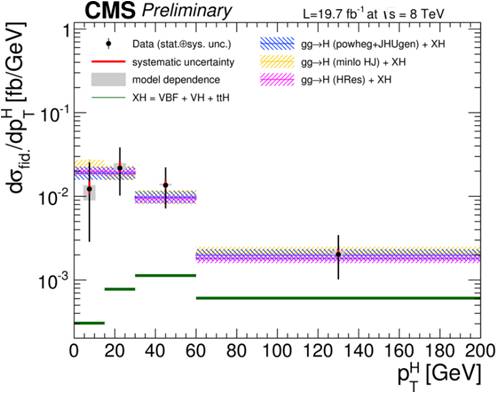
Above, the rate of Higgs production as a function of its transverse momentum. The data is shown by black points with error bars, the theoretical predictions are blue, yellow, and pink bands; the green histogram shows the predicted component by non-gluon-initiated production processes.
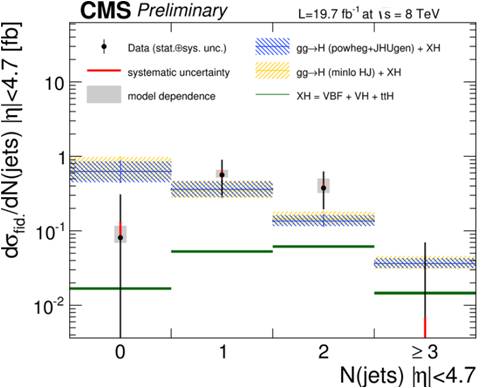
In the graph above you can see the number of jets that accompany higgs production in the data (black points with uncertainty bars) and theoretical predictions. The agreement is good.
One of the interesting new Higgs analyses I could report was a search for Higgs production by vector boson fusion - a process whereby the Higgs boson is produced by two vector bosons, each emitted by one incoming proton. There have been other measurements of this in the past, but the one I described is special because it employs events that only contain hadronic jets in the final state, as the Higgs is sought in its decay to b-quark pairs (each produces a jet). This is extremely difficult as quantum chromodynamic processes produce irreducible backgrounds at enormously higher rates.
The signal was sought by reducing backgrounds in many cunning ways - by increasing with a regression algorithm the invariant mass resolution of the two b-jets, by using a multi-variate discriminant that reduces gluon-initiated jets characteristic of the background processes, and by exploiting the fact that when two vector bosons create a Higgs, there is no "colour flow" radiating from the initial to the final state of the collision, so one expects a smaller amount of radiation and the events are generally cleaner.
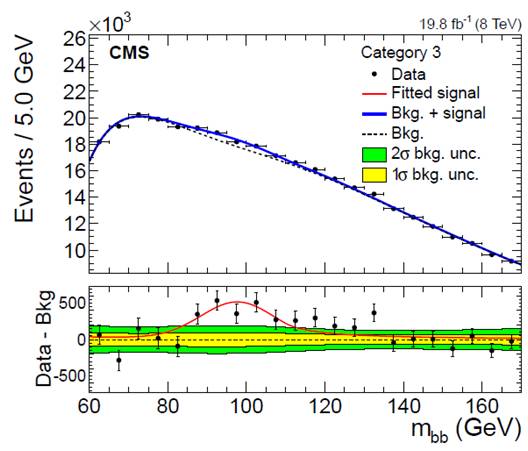
Above: the Z->bb signal extracted from the same data used for the VBF H->bb search. The top part of the graph shows the dijet mass distribution after jet energy regression and a dedicated selection tuned for Z boson decays; the blue line is a fit to signal plus background (dashed). The bottom graph shows the background-subtracted distribution, evidencing the Z->bb signal. The green and yellow band shows the background uncertainty.
The analysis is checked by finding with the same methodology a signal of Z boson decays to b-quark pairs, a subject dear to me (it was my PhD thesis in CDF, where I was the first to extract such a signal in hadron collider data, 17 years ago). Below you can see the Z signal in the mass distribution of events selected for that purpose.
The result of the search is an upper limit on the process, but also a loose measurement of the production rate, which combined with other Higgs decay signals in b-quark pairs by CMS produces a great agreement with SM predictions.
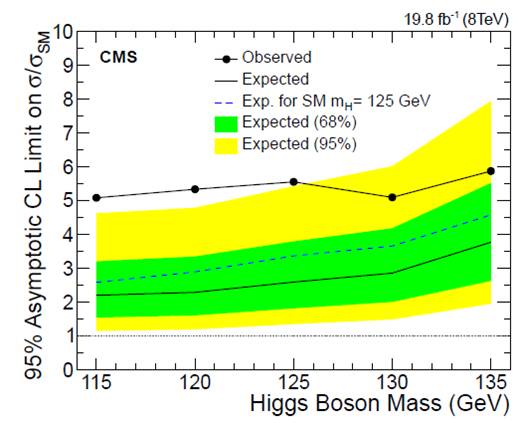
Above: the upper limit on the Higgs rate, in Standard Model prediction units, as a function of the Higgs boson mass. The thicker black curve is the observed limit; the thinner one is the expected limit in the absence of a Higgs boson, and the blue dashed curve shows the expected limit in the presence of the Higgs. The fact that the limit is higher than expected is due to an excess of data above predictions, which is however fully compatible with the SM.
After a few other Run 1 results I was happy to show a few very nice event displays from the new Run 2 data. Below are shown some of the most striking ones (I already published in this blog a 5.4 TeV dijet event, so I will skip that one here).
Below is a very nice diboson event candidate, with two energetic muons and two energetic electrons.
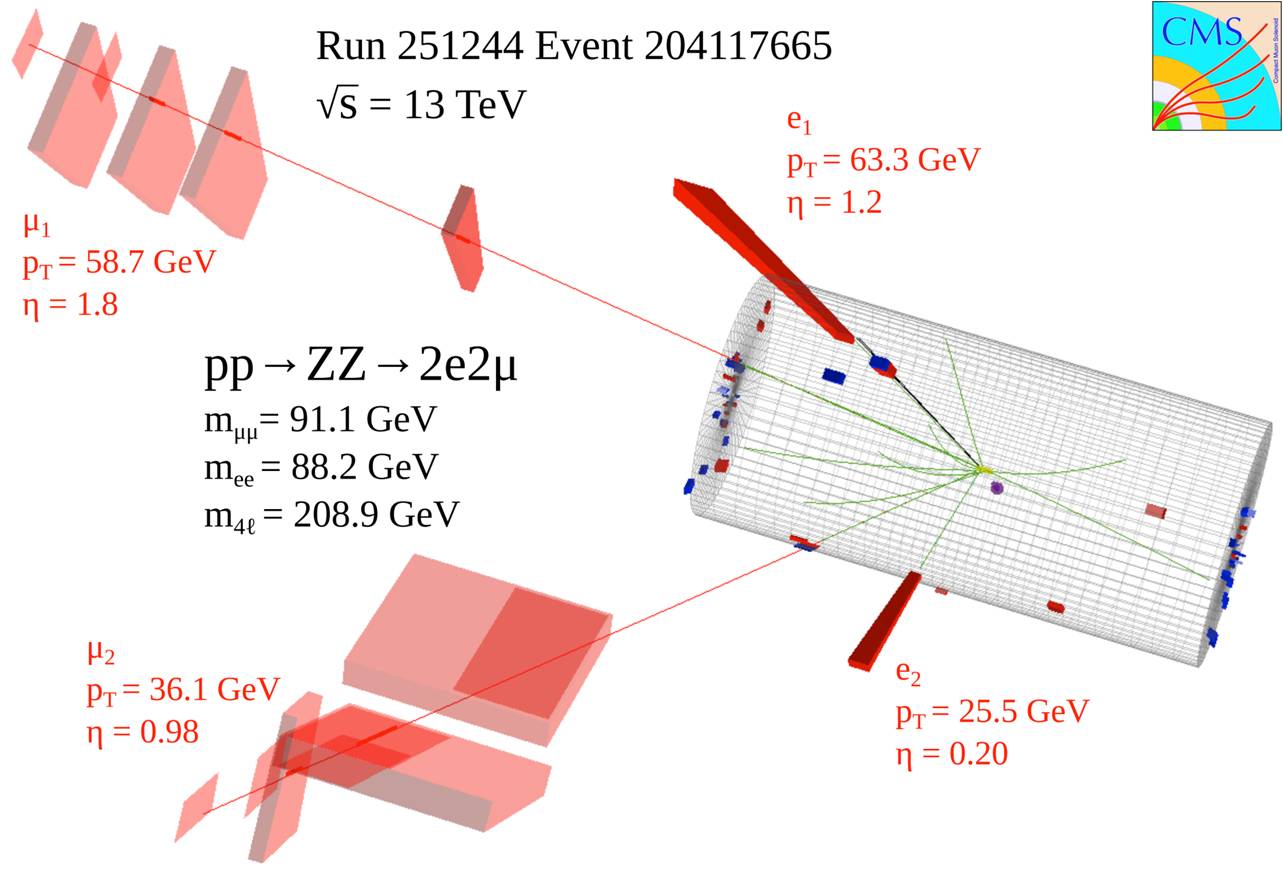
And below is a very energetic dielectron event - the invariant mass of the pair is 1.0 TeV!
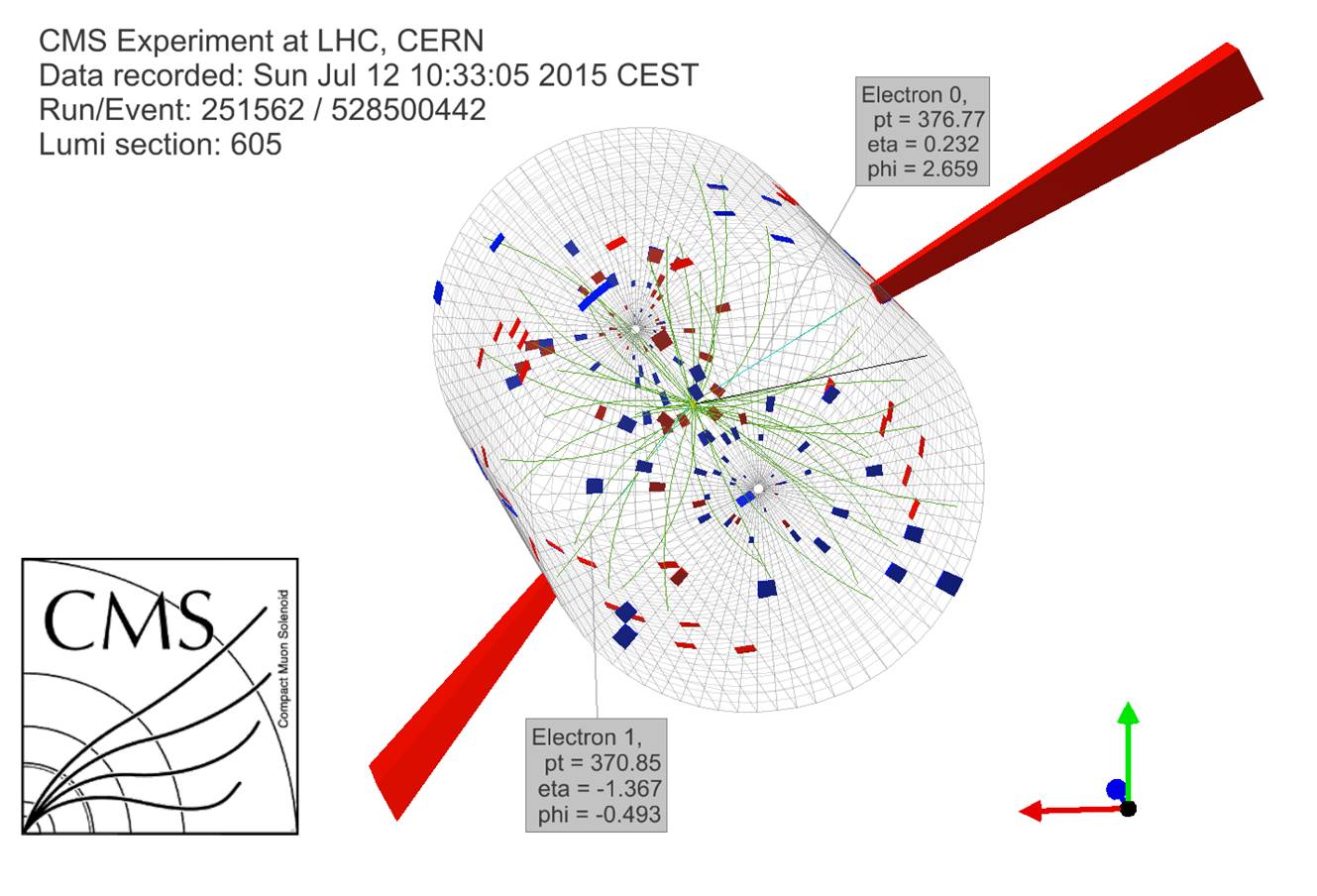 I will publish more such event display in the next post, so that I can describe them with more care. Stay tuned for more exciting Run 2 results!
I will publish more such event display in the next post, so that I can describe them with more care. Stay tuned for more exciting Run 2 results!




Comments